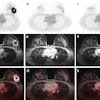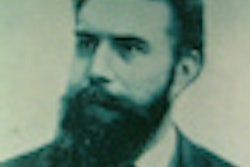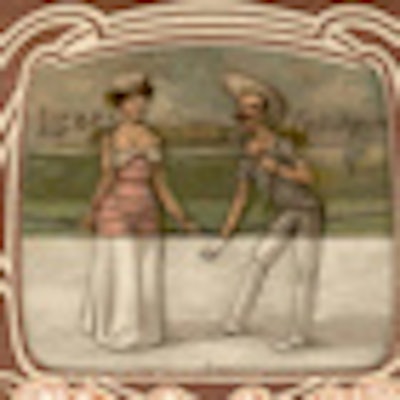
Printed ephemera reveal much about the interface between science and popular culture. In the latest installment of his history column, Dr. Adrian Thomas looks at how imaging was portrayed in picture postcards in the years following the discovery of the x-ray in 1895.
When I first started collecting material related to the history of radiology, I concentrated on "serious" and "important" items, but as the years have passed I have become more and more interested in the interface between science and popular culture and in printed ephemera.1
The term "ephemera" covers a wide variety of printed material; it comes from the Greek and refers to the flies that only live for a day. In recent years there has been an increasing interest in printed ephemera.2 I presented an exhibition of radiological ephemera and popular x-ray material at ECR in 2003. The exhibition was well received and concentrated on popular ephemera, as opposed to the more practical material that is produced by x-ray departments and the radiological industry.
Popular material includes trade cards, postcards, advertising material, and comics. This ephemeral material is poorly known to the radiological community and this is unfortunate, both because of the intrinsic charm of the material and because of the insights that the material gives into contemporary social attitudes.
The modern postcard was introduced in the Austro-Hungarian Empire in October 1869 and was introduced in the U.K. on 1 October 1870. Dr. Emanuel Hermann had written an article titled "Uber eine neue Art der Korrespondenz mittels der Post" (A new way of correspondence by post), which appeared in the Neue Freie Presse on 26 January 1869, encouraging the use of a postal card.
The early postal cards were made of a buff card and measured 89 x 122 mm. In the U.K., the postage rate for these new cards was only ½d, as opposed to the ordinary rate of 1d. The commercial benefit was quickly realized, and these postcards became immensely popular, particularly in the period leading up to World War I, with many millions of cards being printed.
The style of writing on these new cards was different form the older verbose letters, and the texts on the cards had to be brief. A new form of communication developed in much the same way that modern email and text messages are changing the way we communicate today. Pictures were soon printed onto the cards, and the postcards featured many themes. These themes could be comical, propaganda, advertising, novelty, or miscellaneous. Postcard collecting is still a very popular hobby today, with many fairs being held each weekend.
The novelty card shown in figure 1 was published in Austria in 1904. In the middle of the star is a grid. When the fingers are looked at through the grid, the penumbra gives the illusion of seeing the bones and is the basis of the x-ray spectacles (X-Ray Spex) that were popular in the 1950s.
 Figure 1: Front of Austrian novelty card, 1904. All images courtesy of Dr. Adrian Thomas.
Figure 1: Front of Austrian novelty card, 1904. All images courtesy of Dr. Adrian Thomas.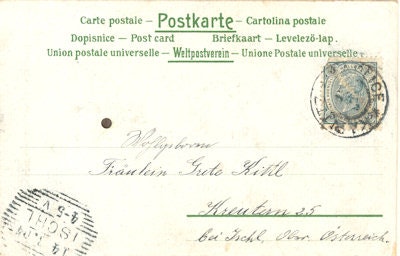 Back of Austrian novelty card.
Back of Austrian novelty card.The second postcard illustrated (figure 2) was made in Germany before World War I (probably around 1900). It shows a young couple on a beach and is titled "Liebeserklärung," which translates as "a declaration of love." Below the picture is written "x strahlen" or "x-rays." In this happy scene, a young couple is seen fully dressed and standing on the beach. By pulling a lever on the base of the card, the image changes. Under the influence of the x-rays, the couple's outer garments are removed and they are shockingly revealed in their swimsuits! Once again, this promotes the popular idea that x-rays are somehow naughty and are showing things that should be kept hidden.
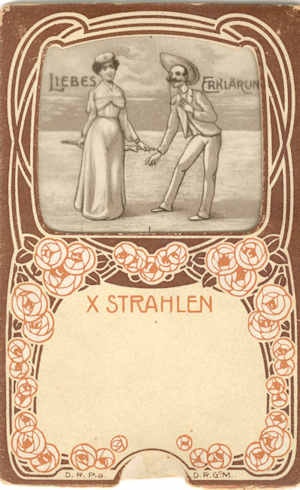
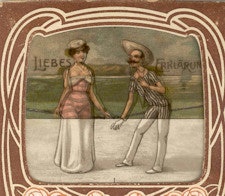
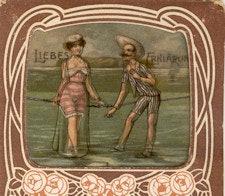 Left: Lever pulled halfway. Right: Lever pulled completely.
Left: Lever pulled halfway. Right: Lever pulled completely.Otto Glasser in his famous biography of Wilhelm Roentgen (1934) quotes the following poem, originally published in Photography:3
The Roentgen Rays, the Roentgen Rays,
What is this craze:
The town's ablaze
With the new phase
Of X-ray's ways.
I'm full of daze,
Shock and amaze;
For nowadays
I hear they'll gaze
Thro' cloak and gown -- and even stays,
These naughty, naughty Roentgen Rays.
If you are a collector of postcards such as those illustrated, I can recommend the U.K. publication Picture Postcard Monthly and its website www.postcardcollecting.co.uk. There are many other interesting websites, including www.postcard.co.uk and www.thepostcard.com.
References
- Thomas AMK, Mould R F. X-ray ephemera, with particular reference to apparatus. Current Oncology. 2004;11:14-33.
- Rickards M, Twyman M. The Encyclopedia of Ephemera. London: The British Library; 2000.
- Glasser, O. Wilhelm Conrad Röntgen and the Early History of the Roentgen Rays. Springfield, IL: C.C. Thomas; 1934.
Dr. Adrian Thomas is chairman of the International Society for the History of Radiology and honorary librarian at the British Institute of Radiology.
The comments and observations expressed herein do not necessarily reflect the opinions of AuntMinnieEurope.com, nor should they be construed as an endorsement or admonishment of any particular vendor, analyst, industry consultant, or consulting group.


